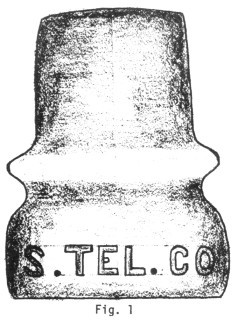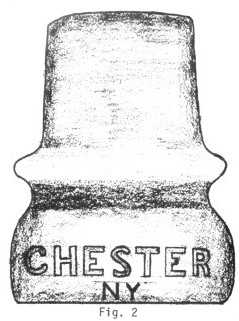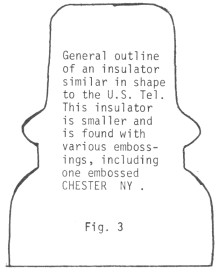"Threadless Corner" -- U.S. Tel. Co.
by Ray Klingensmith
Reprinted from "INSULATORS - Crown Jewels of the Wire", February 1979, page 5
With the
consolidation of several companies in the mid 1850's to form the Western Union
Telegraph Company, there seemed little doubt that nearly all the smaller
companies would eventually be swallowed up by that fast growing giant. In the
late 1850's and early 1860's independent telegraph companies reluctantly gave
way by the dozens to Western Union, until there were few major concerns left to
compete with the "colossal monopoly".
On August 3, 1864 a group of
telegraph companies consolidated to form one large company, to be known as the
United States Telegraph Company. The U.S. Tel. Co. was one of the last major
competitors of Western Union in the early days. The new company was formed from
the merger of the following telegraph companies: Independent, Inland, Inland
Extension, United States, and United States Extension. I am not sure of the
exact dates for the forming of those five previous companies, but from what I've
gathered, I came up with the following approximate years: Original U.S. Tel.
-1859, Independent- 1860, Inland- 1862, U.S. Extension -1862. With the newly
formed U.S. Tel. in 1864 came the promise of a well organized, successful
company. It controlled nearly 10,000 miles of line at various locations and
linked several important points. The man chosen for president of the new
enterprise was James McKaye.
With the formation of a new company determined to
expand, trouble was inevitable. One of the first of many conflicts between U.S.
Tel. and another company came in the state of Illinois in 1864. Judge John D.
Caton, who became a powerful telegraph personality in that state by taking
control of the deteriorating Illinois & Mississippi Telegraph Company in
1852 and making a strong organization of it, stood in the way of U.S. Tel. Caton
had become well known as a powerful telegraph personality in the 1850's as the
merger of companies took place. He was responsible for right of way contracts
for telegraph lines with the leading railroads in Illinois and Iowa. Due to
Caton's control of the lines in the area, it was inevitable that there would be
trouble between him and U.S. Tel. On September 23, 1864, J.J.S. Wilson, Caton's
lieutenant, reported to Caton: "The United States Telegraph folks are
setting poles along the Chicago & Alton Railroad just outside the railroad
company's fence." The same day another employee, L.A. Louis, reported with
similar news: U.S. Tel. Co. agents claimed to have made arrangements with the
Illinois Central Railroad to construct a line along the road on the opposite
side of the tracks that Caton's line occupied. As it turned out, U.S. Tel.
couldn't meet its contracts, and Louis reported to Caton that Mr. Arthur, an
official with Illinois Central, "will cut poles as fast as they (U.S. Tel.) set
them on his right of way."
The Illinois & Mississippi was only
the beginning. Western Union, American Telegraph Company, and U.S. Tel. were
known as "The Big Three" at that time. Western Union and American were
the "Big Two" as far as U.S. Tel. was concerned when it came to
trouble. Western Union, who had the powerful Jeptha Wade (See August and October
'78 Crown Jewels for a feature story on Wade.) on its side, was a great
competitor. Western Union did everything in its power in the early going to
defeat U.S. Tel. They even went so far as to cut their rates on messages below
cost in the areas where U.S. Tel. had competing lines, just to put U.S. Tel. in
a bind.
In July of 1864 the original United States Telegraph Company had an act
of Congress passed authorizing the construction of "a line or lines of
magnetic telegraph between the Missouri River and the City of San Francisco, in
the State of California, on such route as they [the corporators] might select,
to connect with the lines of the said United States Telegraph Company, now
constructed and being constructed through the States of the Union." A
corporation known as the United States Pacific Telegraph Company was to be
formed for the actual building of the proposed line. This proposed line was one
of the major concerns for Western Union, as they already had in operation a line
connecting California with the East. More on that conflict later in the story.
In the early part of 1865 there seemed little doubt that U.S. Tel. Co. would
prosper, despite its competition. It had chosen to have fewer offices,
concentrating mainly on the major populated centers. It also chose to construct
its lines primarily along highways and over farms, rather than along railroads,
so it wouldn't have to share its profits with the railroad companies. However,
this did have certain drawbacks. Inspection of lines was not easy, and separate
facilities for offices had to be provided, whereas telegraph lines along a
railroad could have been inspected easily, and offices were easily located in
railroad depots. The year 1865 was a busy one for U.S. Tel. In April, sixteen
new offices were opened in Delaware, New Jersey, Ohio and Pennsylvania. In June
twelve more were opened on a line from Montreal, Canada, through New York State.
At the end of 1865, the U.S. Tel. Co. was credited with having nearly 16,000
miles of line, and an authorized capitalization of $6,000,000. It was reported
to have gross receipts of $668,422.26.
As stated earlier, the United States
Pacific Telegraph Company was formed to complete a line from San Francisco to
the Missouri River. Western Union had a completed line in that same area at the
time, but that line was highly criticized, due to its being out of operation
much of the time. This was due partly because of troublesome maneuvers of the
Indians. Knowing of a possible competitive line, Jeptha Wade suggested that the
Western Union line be thoroughly repaired and put in working order. He also
proposed a new line to be built along a more southern route, through Denver.
Western Union's main concern with U.S. Tel. was west of the Mississippi, and
therefore concentrated its attack on stopping it in the West. Actual
construction on the line, starting eastward from San Francisco, was put into
full scale in 1865. James Street was directed to construct the line under the
superintendence of James Gamble. In January of 1866 the line was completed to
Salt Lake City From there it was intended to have been built eastward to
Missouri and join its relatively large empire in the East.
Even with the
promising news of the completion to Salt Lake City, there were some indications
the company might fall. In fact, the end was very near. In the middle part of
1865 stockholders in U.S. Tel. Co. started asking questions. There seemed to be
far too little profit for a company of its size. There also were reports that a
contractor hired by U.S. Tel. had become very wealthy off the company, and many
stockholders may have feared there was some wrong doing on the part of the
company directors. The validity of the company became so questionable, that the
company stock value in August was only worth one half what it was in March. In
September it was worth one third, and in October about one fifth. Competing
lines took advantage of the situation by lowering rates and continuing court
battles on right of ways. President McKaye, who had been at the head of the
company since its formation, found himself in an awkward position and resigned.
William Orton, then Commissioner of Internal Revenue, was offered the position,
and not realizing all the matters concerned, accepted. He was not long in
finding the true condition of the company after taking over for McKaye on
November 1, 1865. There was little opportunity for Orton to get the company back
on its feet, as it was losing over $10,000 a month after expenses. In February
of 1866, Jeptha Wade, of Western Union, offered a consolidation proposal. Orton
made a counterproposal, which was a heavy load for Western Union to take on; but
it accepted, and thus eliminated another competitor from the field. The contract
was agreed upon February 27, 1866, and on March 1, 1866 the United States
Telegraph Company was officially merged with the giant monopoly. And there came
to an end to a short lived, but yet determined company.
With at least 300
offices and 16,000 miles of line, the U.S. Tel. Co. certainly must have used
many insulators. What type of insulation was used by U.S. Tel. during the early
going is unknown to me. More than likely several different types of insulators
were in use on its lines, due to the fact that there were already nearly 10,000
miles of line in use when U.S. Tel. was formed in 1864 by the consolidation of
the five companies. A November, 1869 article in The Telegrapher, a New York
newspaper printed monthly by the National Telegraph Union, stated: "The
glass insulator now employed is substantially that first used by the United
States Company, being a sort of compromise between the 'egg' of the Magnetic
line and the well known 'petticoat' or 'umbrella' so much used a few years
since." The CD 731 has been referred to by collectors as "the
compromise", and that type of insulator may or may not be the type referred
to above. There is an insulator embossed U.S. TEL Co. // CHESTER / N.Y. (See
figures 1 and 2 on the following page.) These insulators are rather scarce,
especially in the East, and it is quite a challenge trying to locate one. Most
are of a pretty dark aqua; but I have seen at least one unit in a real light
aqua. The name "Chester" embossed on the insulators refers to a
telegraph equipment supply company formed in the mid 1850's in New York City.
These insulators most likely were ordered from the Chester firm, and made on
special order by a glass manufacturer or supplier somewhere in the East. (See a
Chester ad elsewhere in this article.)
 |
 |
|
U.S. TEL. CO.
insulator, Notice its larger size compared to figure 3, which shows a similar insulator which is found with the Mulford & Biddle and various other
embossings. |
Reverse side of the U.S. TEL. CO. The embossed "NY" near the base
is a characteristic similar to the embossing
found on the CD 729 Mulford & Biddle. |
All the ones located to date, as far as I know, came from the
western part of the country, and were probably from the line which was completed
from San Francisco as far east as Salt Lake City. If anyone knows of their use
elsewhere, please advise me of it.
The embossed U.S. Tel. Co. units are very
similar to an insulator marked MULFORD & BIDDLE // U.P.R.R. However, the
U.S. Tel. Co. ones are somewhat larger and have a skirt which "rounds
into" the base. (See figure 3 on the following page for a comparison.) The
embossing on the U.S. Tel. Co. is rather large, and very neat. Notice in figure
2 the location of the embossing "NY". It is very near the base. This
characteristic reminds me of the CD 729 Mulford & Biddle, 83 John Street,
insulators, as the embossing on those insulators is also very near the base.
Mulford & Biddle was in business in New York City in 1865, and the
insulators made for U.S. Tel. Co./Chester were more than likely produced in that
year also. This brings forth a theory that the supplier to both Chester and
Mulford & Biddle could have been the same firm. The unusual location of the
embossing is one indicator of this.
There seems to be very little known
on who actually produced the early threadless units. There are several different
supply house names embossed on threadless units, such as Chester, Keeling,
Lefferts, Mulford & Biddle, Tillotson, etc. But who made these for them?
That is a question that has been bothering me for some time. It's bothered me so
much that this spring I hope to do enough research to possibly come up with an
answer.

There is one possible supplier of these, Bartlett & Co. of 289
Greenwich Street. Bartlett states in an ad that they were manufacturers and
dealers in glassware. But again, being a manufacturer and dealer doesn't
necessarily mean they produced any insulators at all. (However, I personally
feel that they did make some.) They may have manufactured other types of glass
and ordered insulators from another firm. In the ad, which I've included on
this page, notice that Bartlett advertised the U. S. Pattern. Anyone have any
ideas as to what the U.S. Pattern is?
I guess it's only right that I let everyone know how the new style numbers for threadless are
going along. I've set up some guidelines to go by, and have broken down the
basic groups. I hope to really get things off the ground this winter, and by the
time you're reading this, we should have things well under way.
For those of you
who haven't followed the project too closely, I'll give a little background. For
the past couple of years collectors have been indicating they would like a
separate set of numbers assigned to threadless. I would once again like to make
special note that we already have two fine systems -- Jack Tod's and Mr.
Woodward's. Jack's U- numbers are for U.S. items, and some Canadians may have
felt left out. So the new T.S. numbers will include Canadian porcelain.
Otherwise, Jack's system is fantastic. Mr. Woodward's system is also to be
credited for saving all of us so much confusion. But, once again, some
collectors wanted numbers assigned to the new finds; and a new system has been
suggested.
I have written both Jack and Mr. Woodward for their suggestions on a
new system. I don't really see this new project as a criticism of their
established charts. Both have been very helpful to me in the past in writing the
articles and prior to the articles, helping my knowledge on the hobby. I feel we
can all grow together and better our hobby. The help these two fine individuals
can contribute will be immeasurable, as they have had the experience and know
what to do and what not to do. I certainly look forward to their suggestions.
Also, I want this project to be everyone's project. Contact me with any
suggestions you may have.
As I finish this month's article, I'm reminded that
"Threadless Corner" and "Patent Pages" are both one year old
with this issue. It's been a year of a lot of work, and yet more fun. I've
enjoyed it and hope to continue with the research.
A recent letter from a
discouraged collector really made me realize how close all of us must stay for
us to make this hobby great. There have been a lot of great collectors over the
years, many of whom have contributed so much. As I do my research each month, I
realize what our dear Dora must go through all the time. Folks, let's get the
pencils out and drop her a line to let her know we appreciate her labor of love
toward this growing hobby.
At this time, on the first birthday of the columns,
I'd also like to thank all those who have contributed to them in the past year,
and also all the pioneers of the hobby who did the research many years ago for
us to benefit from. This month a thanks to Ken Waehner for sending some material
so I wouldn't have to forever borrow from Bob Pierce. Thanks, Bob, for allowing
me to use your printed material. Thanks also to the Branhams once again for the
copies of early telegraph ads, and to Dave and Marilyn Delling for their efforts
in producing the book, Before Threads, which has been helpful in confirming
certain information. Thanks to all, and let me hear from you.
|
